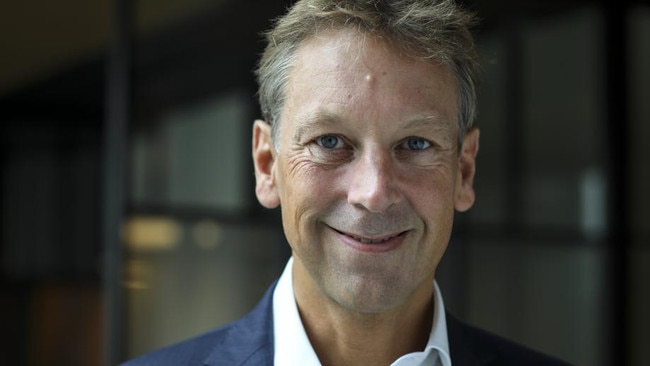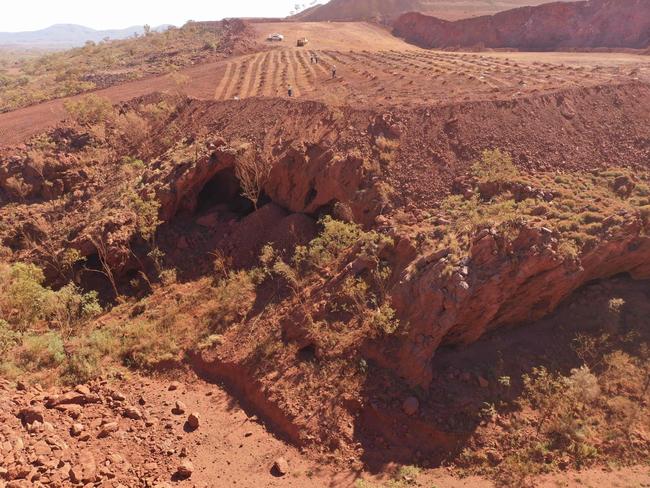Juukan fallout slows Rio Tinto’s plans
The impact of Rio Tinto’s destruction of heritage sites could reverberate through its operations for years, the miner has warned.

The impact of Rio Tinto’s destruction of 46,000-year-old heritage sites in the Pilbara could reverberate through its operations for years, the company has warned, saying it doesn’t know how a renewed focus on relationships with traditional owners will affect its operations.
Uncertainty caused by the fallout of the Juukan Gorge debacle has forced Rio to push back the development of its Winu copper project in the Pilbara, with the mining giant flagging the need for further discussions with traditional owner groups over its development, and saying it could still not quantify the impact of new heritage laws likely to be passed in Western Australia this year on its future operations.
And, in the December quarter production report released on Tuesday, Rio gave its clearest signal yet it intends to push ahead with the development of a giant new iron ore mine at Simandou in Guinea, saying it had launched early works at the project and expected to update technical studies on the infrastructure needed by the middle of the year.
“Activity at the mine area is starting, including roadworks. We are progressing the implementation of the project’s 2012 Social and Environmental Impact Assessment,” Rio said.
Rio finished the year at a rush, shipping 88.9 million tonnes of ore into a roaring market for the steelmaking commodity in the December quarter and lifting output guidance for 2021.
Rio released its December-quarter production report on Tuesday, saying its Pilbara mines shipped at a rate of 355 million tonnes a year in the quarter, taking the company’s annual shipments to 330.6 million tonnes. The mines Rio operates in the Pilbara produced 334.4 million tonnes of iron ore in 2020, up 2 per cent compared to 2019.
The mining giant lifted Pilbara guidance to a range of 325-340 million tonnes in 2021, a record rate if it hits the top end of expected output, but still behind where it expected to be a few years ago.
Rio had originally expected to ship 338-350 million tonnes of iron ore from the Pilbara in 2019, an improvement from the record 338.1 million tonnes it moved into the market in 2018. But fires at processing and handling facilities at its ports, as well as lost shipments from Cyclone Veronica, forced Rio to cut its guidance, to 333-343 million tonnes, and then again when problems with ore movement at its Brockman mines emerged.

Rio’s iron ore division is getting back on track, but is still shipping significant quantities of lower-grade ore — 1.8 million tonnes in the December period, and 6 million tonnes in 2020 — and flagged longer-term impacts from the fallout of the destruction of the heritage sites at Juukan Gorge.
“The future impact on our Pilbara iron ore operations, mine developments and heritage approach from the reform of the Aboriginal Heritage Act 1972 (WA) remains unknown,” Rio said on Tuesday.
“We will maintain a high level of engagement with traditional owners regarding current and proposed plans for mining activities and continue to work through scenarios in an iterative manner as cultural assessments and mine designs progress, with a broad range of options available given the flexibility in our Pilbara network,” Rio added.
But the strong finish to the year ensured Rio was raking in the cash when the price was strongest. Rio said on Monday its product sold for an average $US91 a tonne from the port in 2020, $US12 a tonne ahead of the $US79 a tonne realised in 2019.
But the company warned that its new guidance was still in the hands of the weather, with the Pilbara expecting a severe cyclone season in 2021, as well as its ability to successfully integrate new mines at Robe Valley, West Angelas and Western Turner Syncline Phase 2 into its operations, as well as the start-up of Gudai-Darri (formerly known as Koodaideri), which would hit full production this year.
Rio pushed back the likely development of a new WA copper mine at its Winu discovery by a year, saying it now hoped for first ore from the project in 2024.
Six months ago Rio told the WA government it hoped to begin construction of the mine in mid-2021, but is now flagging slower progress on reaching agreements with traditional owner groups.
“We are actively engaging with the traditional owners through on-country heritage surveys, monitoring and agreement making, which is expected to continue into 2021, with first ore now expected in 2024, subject to regulatory approvals, traditional owner and other consents and COVID-19 restrictions,” Rio said.
But the iron ore price remains key to the start of Jakob Stausholm’s tenure as its new chief executive, and the strong finish to the year ensures he has the firepower to deliver a bumper dividend in the company’s annual financial results next month.
The final result is in the middle of Rio’s annual shipment guidance of 324-334 million tonnes, and represents a strong finish to a horror year for the company — one so bad that the pandemic that closed economies across the globe played only a cameo role on the list of Rio’s woes.
Rio shed chief executive Jean-Sebastien Jacques, iron ore boss Chris Salisbury and corporate affairs head Simone Niven over the decision to blast 46,000-year-old rock shelters at the company’s Brockman mine in order to access higher-grade ore zones.
Already facing major blowouts on cost and timelines, the underground expansion of Rio’s flagship copper mine in Mongolia, Oyu Tolgoi, is now under threat from the Mongolian government, and Rio’s relationship with subsidiary Turquoise Hill Resources has turned toxic.
And with copper also entering a run on the back of rising demand as global governments spend to try to recover from the pandemic, its most important undeveloped asset — the Resolution copper project in Arizona — is also mired in controversy, as traditional owners seek to block construction, arguing it would lead to the destruction of heritage sites.
Rio’s production of refined copper plunged in the year, with output 54 per cent lower at its Kennecott mine in Utah following an earthquake that required a rebuild of the processing plant furnace, and delays restarting the smelter after a maintenance program in the middle of the year.
Rio said it produced 155,000 tonnes of refined copper for the year, against guidance of 135,000- 175,000 tonnes, and down from 260,000 tonnes in 2019. It produced 528,000 tonnes of copper, beating the top end of its 475,000- 520,000 tonne guidance.
Mr Stausholm said Rio had produced a strong operational performance in 2020, despite the challenges posed by the pandemic.
Rio shares closed up 84c at $119.63 on Tuesday.


